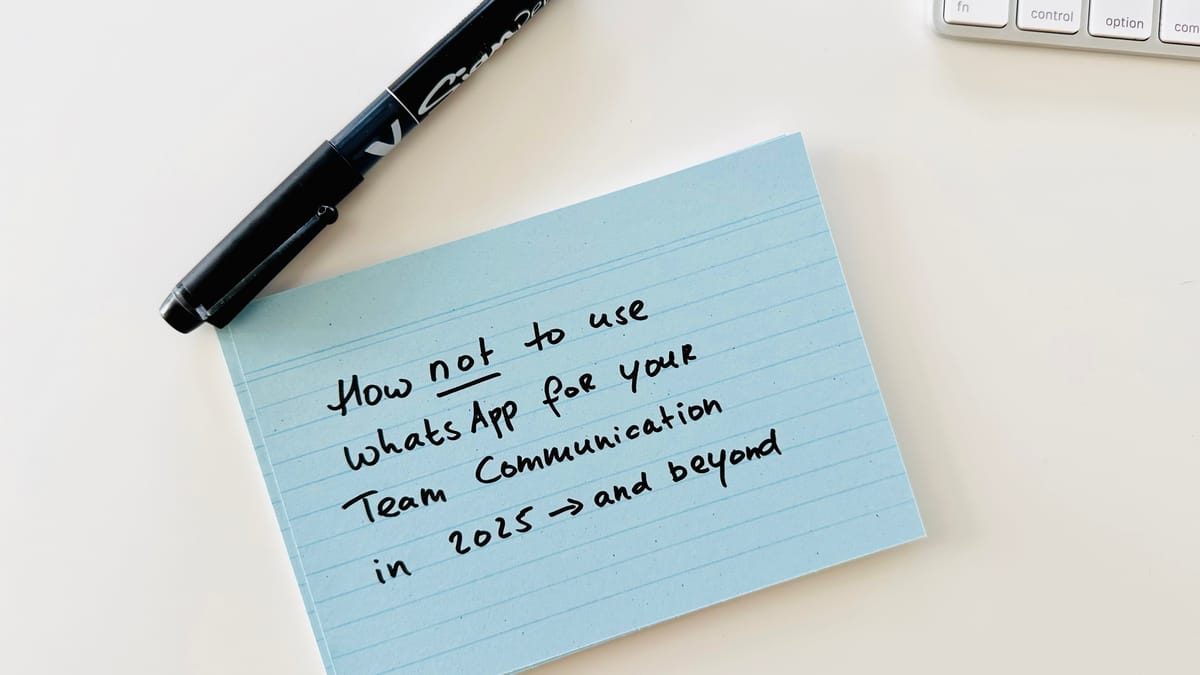Group Chats Are Not Team Communication
Instant messaging tools like WhatsApp make team communication fast and easy — but that doesn’t mean they’re the right tool for every message. In this post, I explore why leadership communication needs more intention, and how group chats can quietly undermine clarity, trust, and team culture.

One of the more underestimated challenges in modern leadership is not what you communicate — it’s how. We’ve never had more channels at our disposal, yet the simple act of communicating clearly across a team has somehow gotten harder. Tools like WhatsApp, Slack, Signal, and iMessage are everywhere. They’re fast, informal, and easy to use. But when it comes to team communication — especially top-down or sensitive topics — they can cause more confusion than clarity.
I’ve seen this play out repeatedly, especially in small, fast-moving teams. When people know each other well and operate on trust, tools like WhatsApp can work incredibly well for pushing day-to-day updates, quick wins, reminders, or a message from the CEO that says, “Hey, here’s what’s happening this week — heads up.” That kind of push-style communication works. It’s fast, direct, and understood.
But the moment these channels shift from pushing updates to inviting discussion, things get tricky.
The Trap of Open Discussions in Closed Threads
Not every team is comfortable voicing opinions in group chats — especially when the topic is sensitive or ambiguous. One person might confidently speak up and unintentionally steer the conversation in a direction that doesn’t reflect how others feel. Others may go silent, even if they disagree. The illusion of alignment sets in, but under the surface, you’ve created tension instead of clarity.
I’ve worked with teams where group chats became a substitute for real dialogue — and it never ends well. The quieter people feel overlooked. The louder voices set the tone. And leadership ends up with a false sense of consensus. For complex or emotionally charged issues, these channels simply don’t create the kind of psychological safety needed for real communication.
The Cost of Public Layoff Announcements
One particularly painful example came from a company I worked with recently. They had to lay off several employees — not because of a single event, but because they were restructuring how they delivered quality and service across the board. The leadership team had spent weeks thinking through the new direction and believed they were making a long-term bet on excellence.
The problem wasn’t the decision. It was how it was communicated.
The layoffs were announced broadly, before individuals had been properly briefed. In an attempt to be transparent, leadership shared the overall reasoning behind the restructuring — but that meant individual employees were left reading between the lines, wondering what exactly applied to them, how their performance had been judged, or whether they’d been grouped in unfairly.
Layoffs are always personal. No matter how strategic the decision may be, no two employment relationships are the same. People have different histories, contracts, family situations, health concerns. You can’t address all that nuance in a WhatsApp message — and you shouldn’t try.
When and Where You Speak Matters
This isn’t just about layoffs. It applies to any big shift — strategy changes, new leadership, realignments of responsibility. If the message is critical, the delivery has to match. A broadcast sent to everyone’s phone late at night or a poorly worded message in a group chat creates unnecessary confusion and stress. It also erodes trust.
That doesn’t mean you shouldn’t use instant messaging tools at all — they absolutely have a place. But leaders need to distinguish between the channel and the message. Not everything should go into a group thread. And not everything should be up for open discussion.
If you’re sharing direction or reinforcing strategy, make it clear: is this a request for feedback? Or is this a final decision? Don’t leave that open to interpretation. The more ambiguity you create in open threads, the more likely it is that people will misunderstand your intention — or worse, shape the message on your behalf.
Use Broadcasts, Not Group Threads
One practical shift that’s worked surprisingly well in my experience is the use of WhatsApp broadcasts instead of group messages.
With a broadcast, every employee receives the message individually, but you don’t open the door to a chaotic backchannel discussion. It feels personal, but professional. It sets the tone: “Here’s something important we need you to know.” If people want to respond, they can do so one-on-one — where the nuance and clarity can be handled properly.
This also avoids the problem of crossing into employees’ personal space. Group chats often blur the lines between work and private life, especially when people are expected to be reachable after hours. With a broadcast, you’re addressing them as a professional, not expecting them to perform emotional labor in front of their peers.
Communication is Design
At the end of the day, good communication is about structure and intent. If you want to foster open conversations, make time and space for that — in person, on Zoom, in small groups. If you’re communicating decisions, deliver them clearly and respectfully, and don’t offload the emotional impact onto the team by hiding behind group messages.
The most effective communication isn’t about how many messages you send — it’s about whether the right people understand what matters, and what they’re expected to do with that information.
WhatsApp might be fast. But leadership requires something slower, more intentional, and more human.


